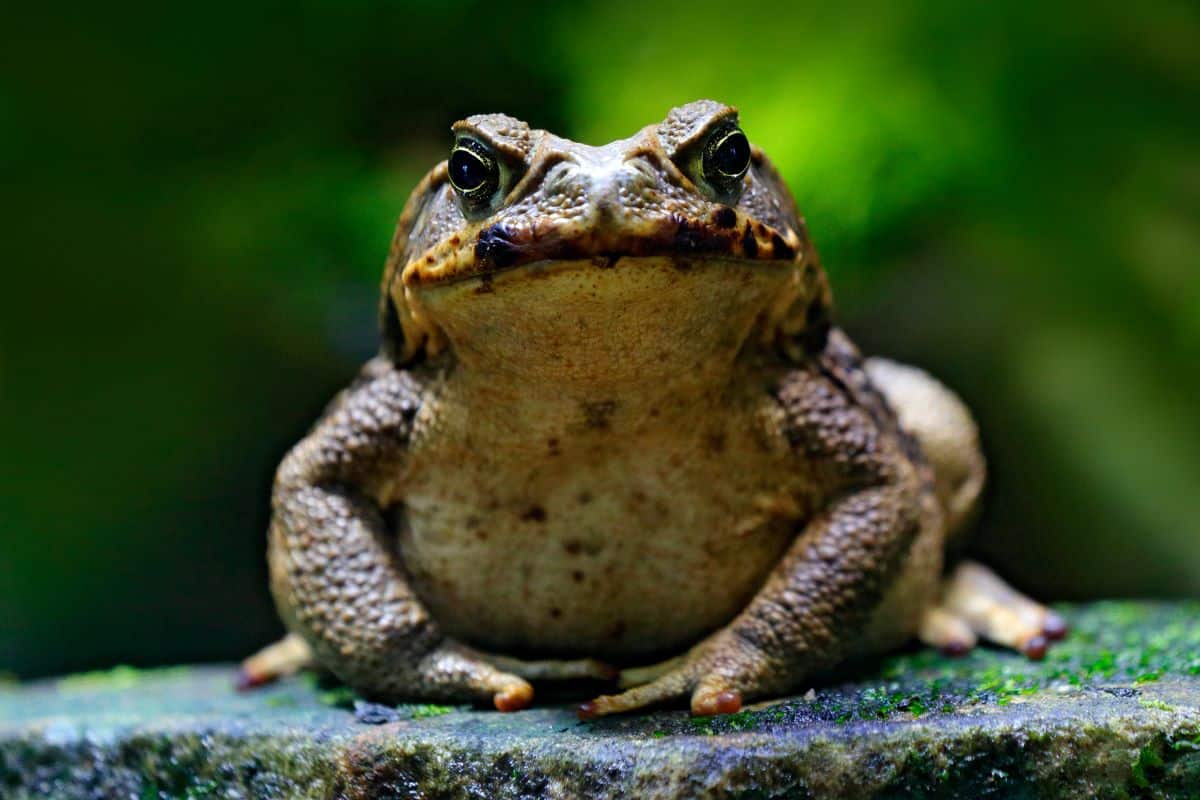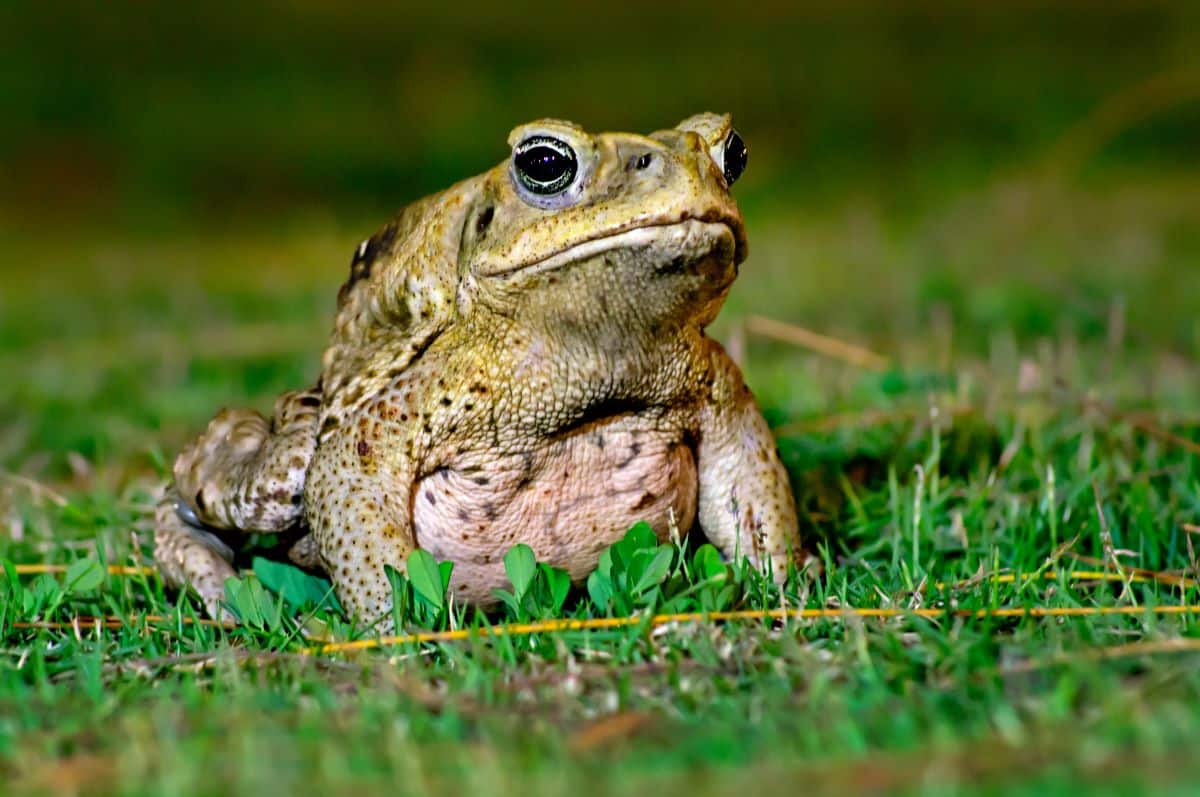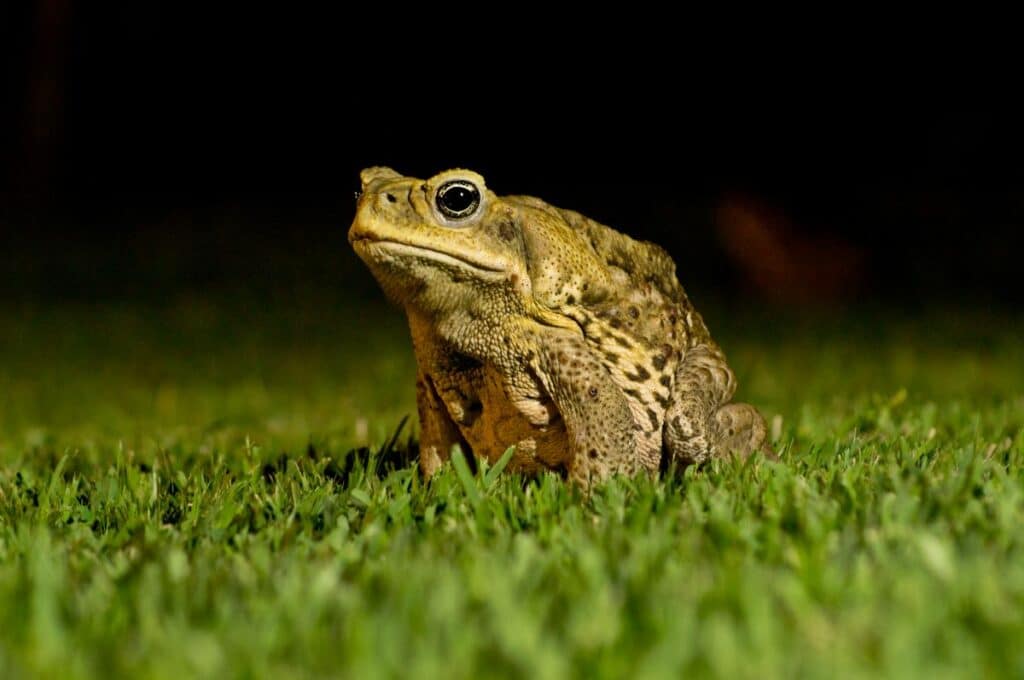the essentials in brief
The cane toad mainly eats insects and small vertebrates. Everything else here...
They are not common pets as they are venomous and are invasive species in some countries. Read more here...
The size of a cane toad varies, but they can typically grow to between 10 and 15 inches in length.
The cane toad is one of the largest and most controversial amphibian species in the world. It has been introduced to various countries as a pest control agent, where it has become an ecological threat.
What makes the cane toad so special? how does she live And how can you recognize them? In this blog post you will learn everything you need to know about the cane toad.
The Story of the Cane Toad

The cane toad has a long and turbulent history. Already in the 19th century it was introduced on some Caribbean islands to control pests on sugar cane plantations.
This practice continued in many other countries throughout the 20th centuryespecially in Australia and the Pacific Rim.
The idea was that the cane toad would help protect the crops by eating the harmful bugs and caterpillars.
However, it soon turned out that this method was not only ineffective, but also serious consequences for ecosystems had. The cane toad multiplied rapidly and was spread over wide areas.
She not only fed on insects, but also from other animals, such as frogs, lizards, snakes or small mammals.
Note: Cane toads are nocturnal animals and are often attracted to streetlights. This can lead to traffic accidents. When driving in such areas, pay extra attention to the road.
Many of these animals were playing an important role in the food chain, were involved in pollination or contributed to soil quality.
So the cane toad reduced biodiversity and the natural balance.
Added to this was the cane toad in the new areas almost no natural enemies had. Most predators gave it a wide berth because of its unsavory appearance or quickly learned that it was poisonous.
Only a few animals, such as B. some crow species or monitor lizards were able to adapt by tolerance or evasion of the venom.
Most of the other animals died from the poisoning or suffered from starvation.
This is how the cane toad went from being supposedly beneficial to a dreaded pest.
Today it is considered one of the worst invasive species in the world and as a serious threat to biodiversity and agriculture.
The Biology of the Cane Toad: Adaptable and Predatory
The cane toad is a fascinating animal capable of adapting to a wide range of environmental conditions. It exhibits a number of traits that set it apart from other toads and give it an edge in survival.
Size
The cane toad is one of the largest toad species in the world. It can grow up to 22 centimeters long. Their weight is up to 1,5 kilograms.
The females are significantly larger than the males. This size allows the cane toad to capture larger prey and defend against smaller enemies.
Skin
The cane toad has warty skin that in different shades of brown is colored. The skin is used for camouflage, protection against dehydration and as a poison store.
The cane toad has in her skin a set of glands for the production of various substances. The most important are the parotid glands behind the eyes. They can secrete a potent toxin called bufotoxin.
This poison serves both for defense against predators and as a weapon to attack prey. The venom can cause varying effects depending on the dose, from skin irritation to nausea to death.
Reproduction
The cane toad is very fertile and can reproduce all year round. Mating is usually performed in standing water such as ponds, lakes or ditches.
The male clings to the female from behind, encouraging her to lay eggs. In a long tube of gel that expands in the water, the female can up to 36.000 eggs lay down.
Attention: If you live in areas where cane toads occur, be careful as they are poisonous. Avoid touching or provoking her.
The eggs are fertilized simultaneously with the male's sperm. have the eggs a black color and are about half an inch long.
After a day or two, the tadpoles hatch depending on the water temperature. The tadpoles are also black and have a flattened body with a long tail.
They feed on algae, bacteria or organic waste in the water. Until you after about two months transformed into little toads, they go through several stages of development.
Nutrition
The cane toad is a predatory carnivorewho eats just about anything he can get his hands on. It has a large mouth with small teeth that it uses to swallow its prey.
Through olfactory stimuli or movements he tracks down his prey. It feeds on insects, worms, snails, spiders, amphibians, reptiles, small mammals and birds.
It will also eat carrion, waste, or pet food if it finds it. Large amounts of food can be ingested and stored.
The voice
The cane toad has a loud and distinctive voice. Especially in the mating season, a long drawn-out, nasal call resembling a "Waaaa" sounds.
reputation can up to 20 seconds long and can be heard over a distance of several hundred meters. The males call to attract the females or to drive away other males.
The calls of the females are less often and quieter. The call of the females is rarer and quieter than that of most other toad species.

Fighting the Cane Toad
The cane toad is an invasive species with numerous negative environmental and social impacts.
She causes damage in agriculture, is a threat to native wildlife and a hazard to human and domestic animal health.
That's why stopping or at least slowing the spread important to the cane toad. There are different ways to control cane toads, more or less effective depending on the situation.
Here are some ways you can contribute:
prevention
The best way to combat the cane toad is to to prevent their spread. This means that you should not keep or release cane toads as pets.
Also, do not bring or introduce plants or animals from infested areas, do not contaminate water bodies with cane toad eggs or tadpoles, and do not leave litter or pet food that could attract cane toads.
Control
Controlling or reducing their population is another way to control the cane toad. This can through promoting their natural enemies or by introducing new enemies through you.
For example, you can feed or settle crows or monitor lizards that can eat the cane toad.
You can also use biological weapons like viruses or parasites insert. These can specifically infect and weaken the cane toad.
The fascination of the cane toad: why it is interesting despite everything
Although the cane toad is an invasive species that brings with it many problems, it is also an interesting animal, which has many aspects that make it different from other toads and make it fascinating.
Here are some reasons why the cane toad is interesting despite everything:
The culture
The cane toad looks up a long and varied history in their relationship to humans. It was revered, feared, used or fought by different cultures.
For example, it was used by the ancient Maya as a symbol of rain and fertility and has been depicted in both art and religion.
Did you know already?
Cane toads are notorious for their toxicity. They excrete toxic secretions that can be potentially dangerous to other animals and even humans.
She was with the aborigines of Australia a delicacy and an Aboriginal food. Or it was used by modern people as pest control or as a pet - or even persecuted.
Medicine
The cane toad played a special role in medicine. she got both as a remedy and as a drug .
As a Painkiller, antiseptic or aphrodisiac their poison was used by different peoples. Some people also abused the plant as an intoxicant. They smoked or licked their venom.
But the poison can also cause dangerous side effects such as hallucinations, heart failure or death.
Science
The cane toad is an exciting object for science. It offers many opportunities for research and teaching.
For example, it can be used as model organism for research into amphibians, of toxins, of invasions, or of adaptations.
Or it can be used as a source to develop new medicines, materials or technologies.
For example, a new pain reliever, epibatidine, which is 200 times stronger than morphine, synthesized from lizard venom.
The cane toad is still of great importance
The cane toad is a fascinating animal with many aspects that make it different from other toads and interesting. It has a long and eventful history that connects it with different cultures and regions.
It has a special biology that allows it to adapt and survive in different environmental conditions. It has played an important role in medicine and science and has led to new findings and developments.


